Convenience Store Business Plan Template & PDF Example
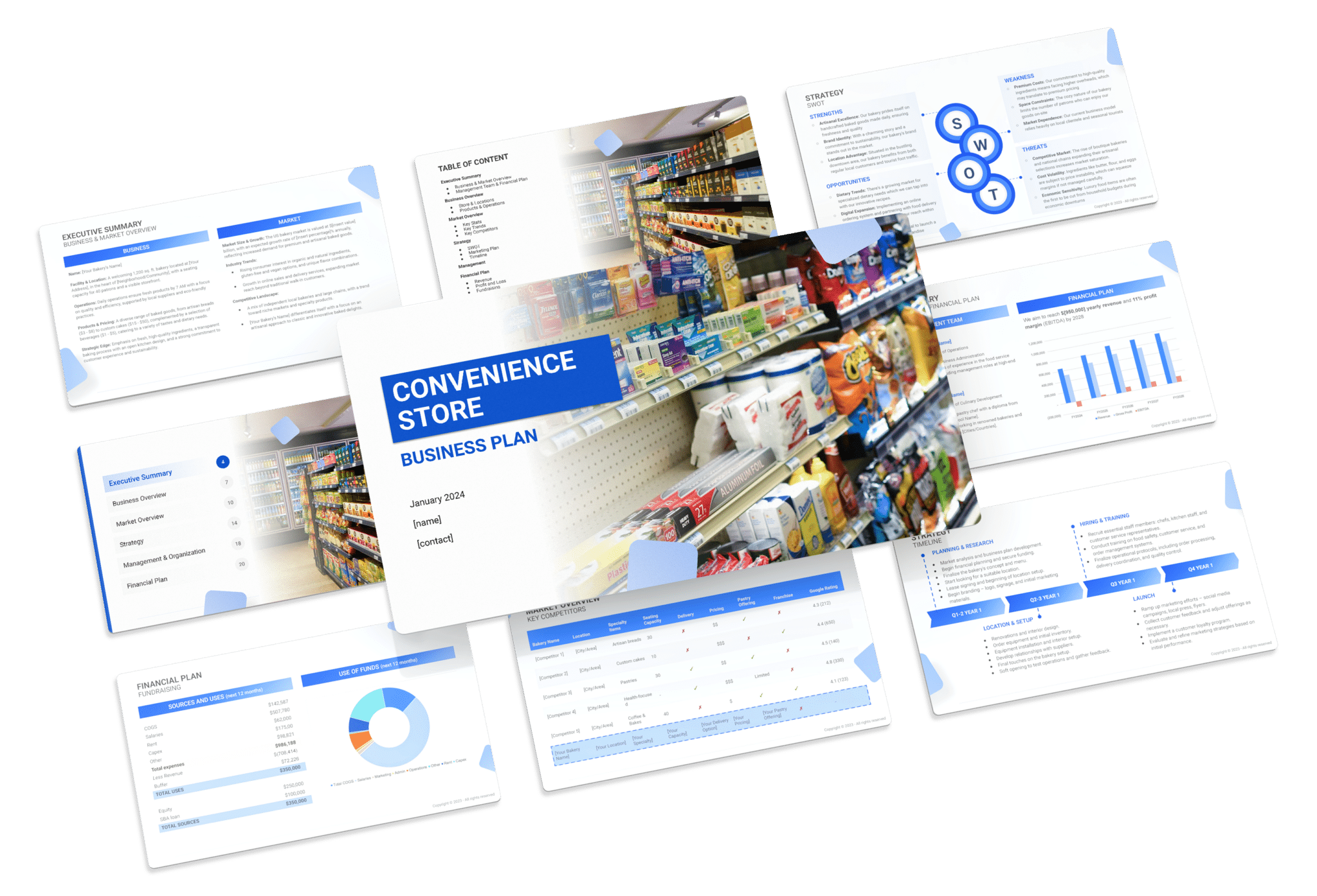
Creating a comprehensive business plan is crucial for launching and running a successful convenience store. This plan serves as your roadmap, detailing your vision, operational strategies, and financial plan. It helps establish your convenience store’s identity, navigate the competitive market, and secure funding for growth.
This article not only breaks down the critical components of a convenience store business plan, but also provides an example of a business plan to help you craft your own.
Whether you’re an experienced entrepreneur or new to the retail industry, this guide, complete with a business plan example, lays the groundwork for turning your convenience store concept into reality. Let’s dive in!
The Plan
Our convenience store business plan is structured to encompass all key components necessary for a well-rounded strategic approach. It details the store’s operations, marketing strategies, market context, competitive landscape, management structure, and financial outlook.
- Executive Summary: Provides an encapsulated view of the convenience store’s business concept, market analysis, management framework, and financial strategy.
- Business Overview: Offers an in-depth look at the convenience store’s offerings and operational model:
- Store & Locations: Describes the store’s layout, location advantages, and why it’s appealing to potential customers, emphasizing convenience and accessibility.
- Products & Operations: Lists the wide range of products offered, from snacks and beverages to household essentials, and details the operational aspects such as inventory management and customer service.
- Market Overview: Investigates the convenience store industry, identifying market dynamics and how the store positions itself:
- Key Stats: Provides industry size, growth trends, and critical statistics for the convenience store market.
- Key Trends: Outlines recent trends impacting the convenience store sector, like the rise in health-conscious products and digital payments.
- Key Competitors: Analyzes the main competitors in the vicinity and distinguishes how the store differentiates itself from them.
- Strategy: Details the approach the convenience store will take to achieve growth and attract customers:
- SWOT: A thorough analysis of strengths, weaknesses, opportunities, and threats.
- Marketing Plan: Strategies for enhancing brand visibility, attracting, and retaining customers.
- Timeline: Significant milestones and objectives from the store’s setup through the first year of operation.
- Management: Information about the individuals leading the store and their roles, emphasizing their experience in retail management and customer service.
- Financial Plan: Projects the store’s financial performance over the next five years, including revenue, profits, and anticipated expenses, with a clear outline of funding strategies to support growth and operations.

Executive Summary
The Executive Summary introduces your convenience store’s business plan, providing a succinct overview of your store and its offerings. It should detail your market positioning, the range of products and services you offer, including groceries, household items, and quick-service foods, its location, size, and an overview of daily operations.
This section should also delve into how your convenience store will fit into the local market, including an analysis of the number of direct competitors in the area, identifying who they are, along with your store’s unique selling points that set it apart from these competitors.
Moreover, you should include information about the management and co-founding team, detailing their roles and contributions to the store’s success. Additionally, a summary of your financial projections, including revenue and profits over the next five years, should be presented here to offer a clear view of your store’s financial strategy.
Convenience Store Business Plan Executive Summary Example
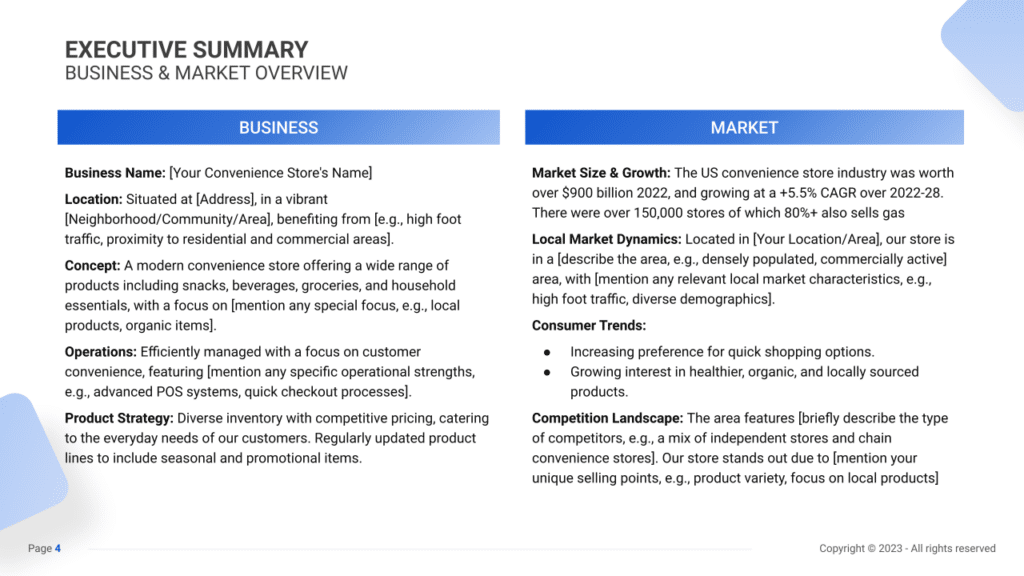
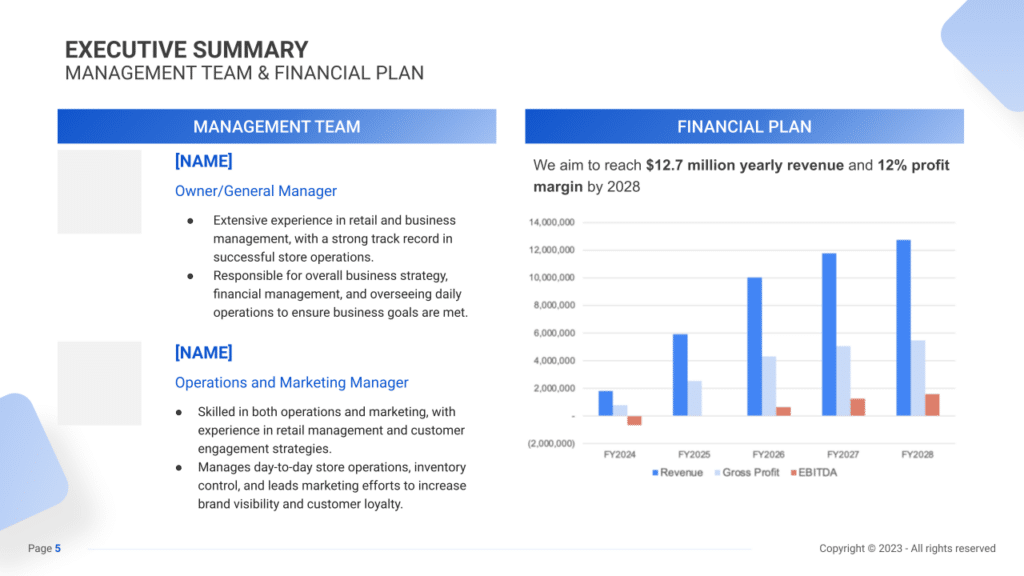
Business Overview
Provide a brief introduction to your convenience store, including its name, prime location, the concept behind your product selections, and your operational approach.
Highlight what distinguishes your store, such as your focus on local or organic products, an emphasis on customer convenience, or a unique store layout that enhances the shopping experience. Your unique value proposition (UVP) should be clear and enticing, demonstrating the specific advantages your store offers to customers.
Example:
“Quick Stop Essentials,” located at the heart of Downtown Commerce District at [Address], offers a comprehensive selection of snacks, beverages, groceries, and household items, with a special emphasis on organic and locally sourced products. Our store is optimized for convenience, featuring a streamlined layout, fast checkout processes, and a customer-friendly environment, setting us apart in a dynamic marketplace.
Market Overview
Discuss the size and growth of the convenience store industry, local market dynamics, consumer trends, and the competitive landscape. Address the growing consumer demand for convenience, the interest in healthier options, and how your store is positioned to meet these needs.
Example:
The convenience store sector, with a valuation exceeding $900 billion, is expanding steadily, fueled by consumer demand for quick and easy shopping solutions. “Quick Stop Essentials” is strategically placed in a bustling urban area, known for its high foot traffic and diverse demographic. Despite the presence of several competitors, our dedication to providing a wide range of products, including healthier, organic options, positions us for success in a market that values convenience and quality.
Management Team
Introduce the key management team members, showcasing the expertise and leadership driving your convenience store.
Example:
“Quick Stop Essentials” is spearheaded by founders Jane Doe and John Smith. Jane, with her deep retail management background, is responsible for the store’s strategic direction and financial health. John, known for his operational and marketing acumen, handles the day-to-day store management, inventory optimization, and customer engagement initiatives. Together, they bring a wealth of experience and a dynamic approach to the convenience store business, steering it towards its ambitious objectives.
Financial Plan
Outline your financial goals and projections, including revenue targets and profit margins, to present a solid financial outlook for your convenience store.
Example:
“Quick Stop Essentials” aims to achieve $12.7 million in annual revenue by 2028, with a 12% profit margin. Our financial strategy includes expanding our product offerings, enhancing customer service, and leveraging targeted marketing campaigns to boost brand awareness and customer retention, ensuring steady growth and a strong presence in the competitive convenience store market.
Business Overview
For a Convenience Store, the Business Overview section can be effectively organized into 2 main slides:
Store & Location
Briefly describe the store’s physical setup, focusing on its layout, ease of navigation, and the inviting atmosphere that welcomes customers. Mention the store’s location, emphasizing its accessibility and the convenience it offers to customers, such as proximity to residential areas or ease of parking. Explain why this location is beneficial in attracting your target customer base.
Products & Operations
Detail the range of products and services offered, from basic groceries and household essentials to quick-service food items and possibly even niche products tailored to local preferences. Outline your operational strategy, ensuring it reflects efficiency, quality of offerings, and matches the market you’re targeting. Highlight any special offerings, such as local produce, organic sections, loyalty programs, or promotional deals that provide added value to your customers, encouraging repeat visits and customer loyalty.
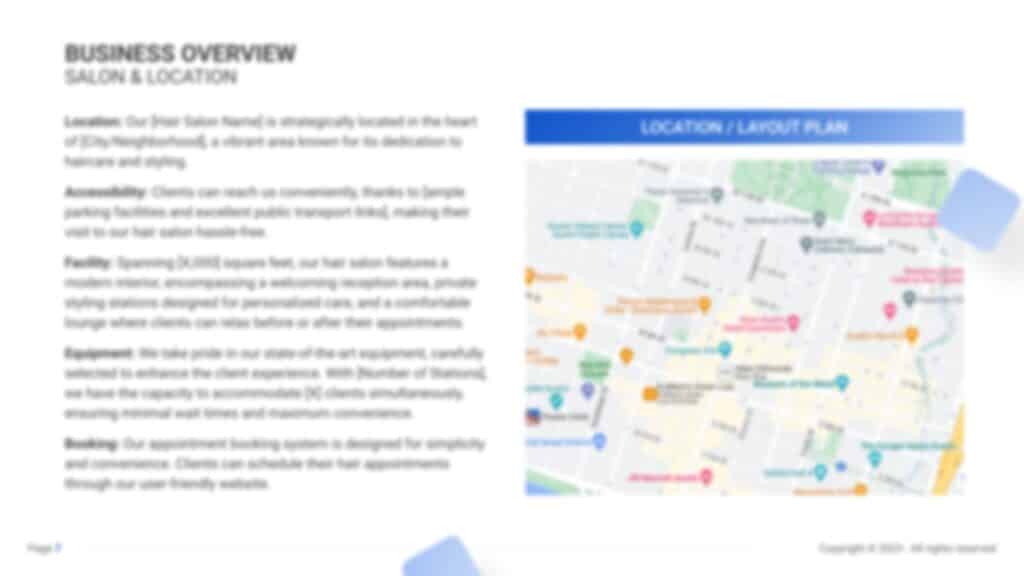
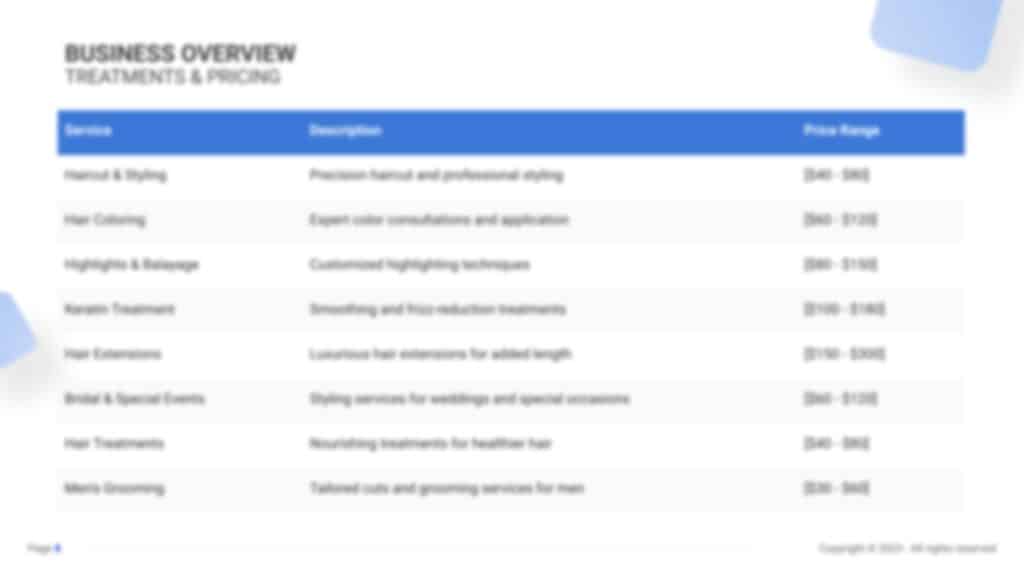
Market Overview
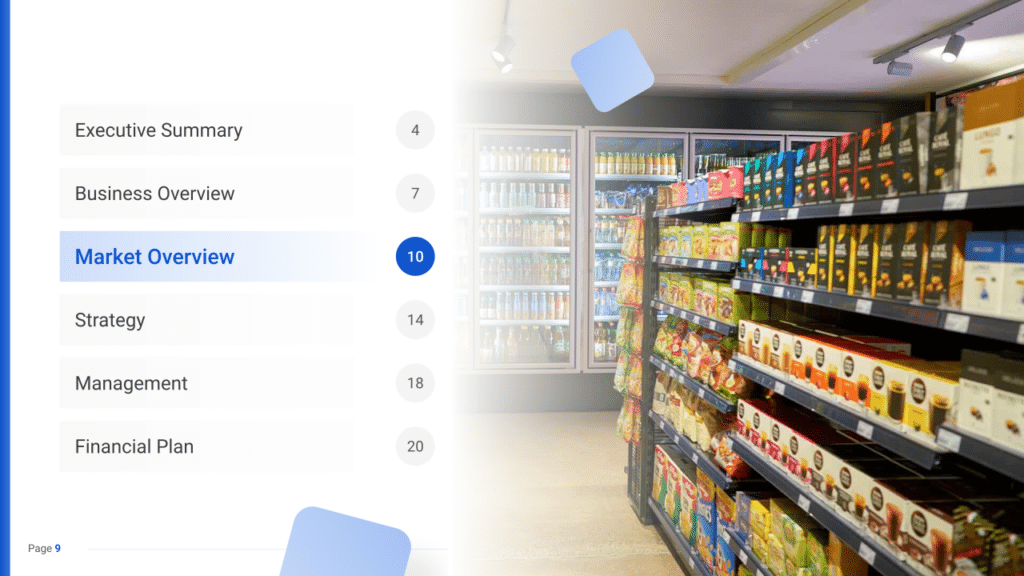
Industry Size & Growth
Begin with an analysis of the retail convenience sector’s size and growth potential to understand market opportunities.
Key Market Trends
Highlight trends such as increased demand for quick access to essentials, healthy and organic products, and ready-to-eat meals. Note the rise in stores offering additional services like bill payments and parcel collection.
Competitive Landscape
A competitive analysis is not just a tool for gauging the position of your convenience store in the market and its key competitors; it’s also a fundamental component of your business plan.
This analysis helps in identifying your convenience store’s unique selling points, essential for differentiating your business in a competitive market.
In addition, the competitive analysis is integral in laying a solid foundation for your business plan. By examining various operational aspects of your competitors, you gain valuable information that ensures your business plan is robust, informed, and tailored to succeed in the current market environment.
Identifying Your Convenience Store’s Competitors
Commence the competitive analysis by identifying direct and indirect competitors within your area. Direct competitors may include nearby convenience stores, gas station markets, or smaller local shops offering similar convenience items. Indirect competitors could encompass larger supermarkets, online grocery delivery services, or fast-food outlets providing quick snack options.
Leverage digital resources like Google Maps, Yelp, and social media platforms to map out competitor locations and gather insights from customer feedback. Assessing these reviews allows you to comprehend competitor strengths, like extended operating hours or a diverse product range, along with their weaknesses, such as limited fresh produce options or outdated store layouts.

Convenience Store Competitors Strategies
Delve deeply into several key areas to comprehend competitor strategies:
- Product and Service Offerings: Analyze the breadth and depth of products offered. For instance, if a competitor like “Convenient Picks” emphasizes organic and sustainable options, it indicates a response to the increasing consumer demand for healthier choices.
- Pricing and Promotional Strategies: Compare pricing structures and promotional tactics. Determine if your store’s pricing aligns competitively or if there’s a need to adjust based on your target market. Assess loyalty programs, discounts, or bundled offerings utilized by competitors to attract and retain customers.
- Store Layout and Convenience Factors: Evaluate the store layout and customer convenience aspects. Does a competitor prioritize a quick in-and-out shopping experience or focus on a more leisurely shopping atmosphere? Understanding these preferences aids in tailoring your store layout to cater to specific customer segments.
- Technology Integration and Convenience Enhancements: Assess the use of technology. Are competitors implementing online ordering, mobile apps for customer engagement, or contactless payment methods? Integrate these insights to enhance the overall shopping experience for your customers.
- Location Analysis and Accessibility: Consider the geographical advantages or limitations of competitor locations. A convenience store situated near a busy commuter route might emphasize ready-to-eat options and on-the-go snacks, while one within a residential neighborhood could prioritize household essentials and personalized services.
What’s Your Convenience Store’s Unique Value Proposition?
Craft a clear and compelling value proposition for your convenience store. Whether it’s offering an extensive selection of locally sourced snacks, providing exclusive ready-to-eat meal options, or promising the freshest produce in the vicinity, highlighting these distinctive features differentiates your store from competitors.
Utilize customer feedback and market trends to identify unmet needs. Suppose there’s an increasing demand for organic produce or a lack of 24-hour convenience options in your area. In that case, tailoring your offerings to fulfill these gaps presents a valuable market opportunity.
Consider your convenience store’s location and the preferences of the local demographic. A store situated in a bustling commercial area might focus on providing quick, on-the-go meals and essentials for busy professionals, while a store located in a residential neighborhood might prioritize a family-friendly atmosphere and a curated selection of household goods.
Strategy
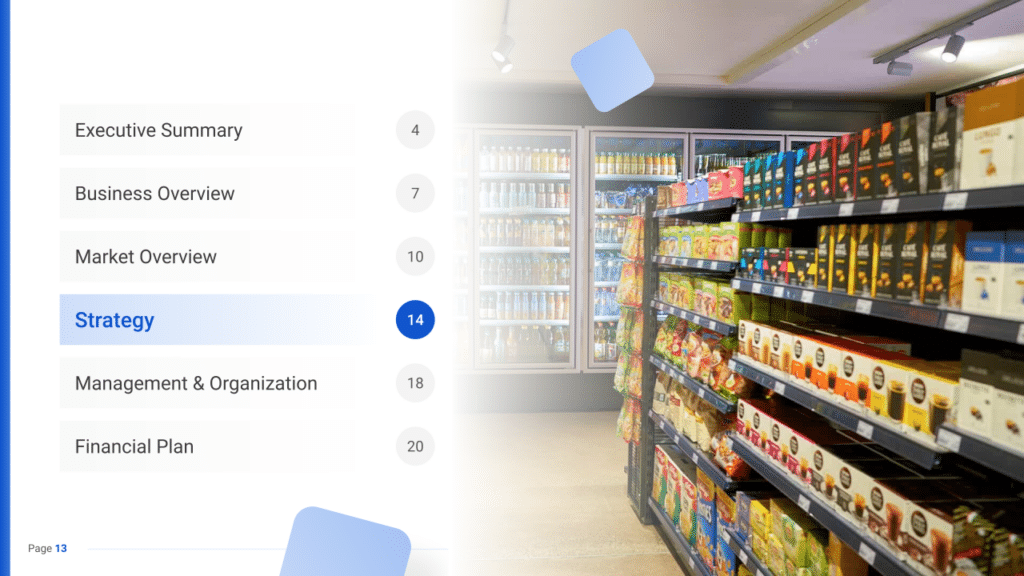
SWOT
First, perform a SWOT analysis for the convenience store, identifying Strengths (like a strategic location and diverse product range), Weaknesses (such as limited floor space or high competition), Opportunities (for instance, the growing demand for quick and easy shopping options), and Threats (like economic shifts that may affect consumer spending on non-essential items).
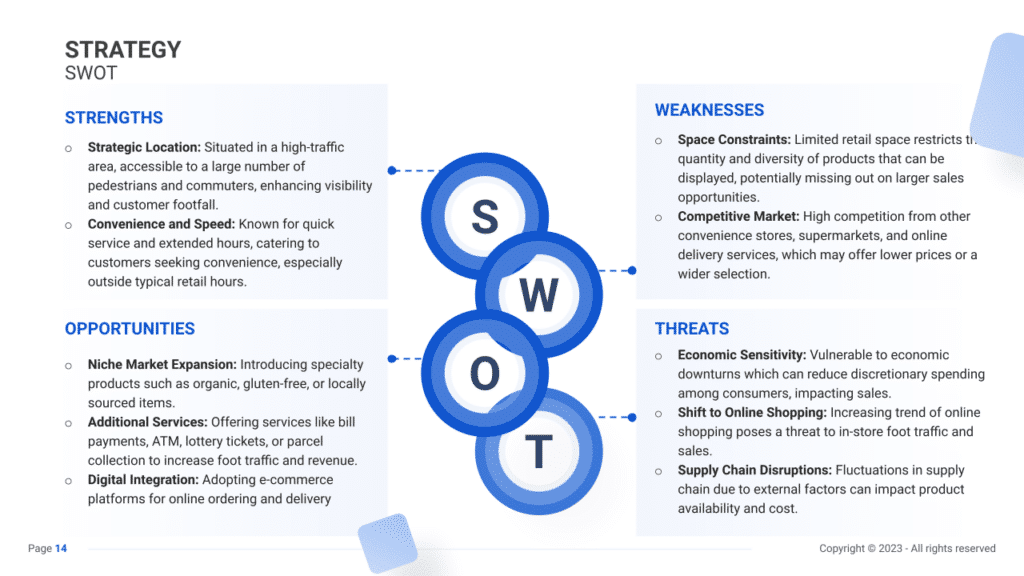
Marketing Plan
Next, formulate a marketing plan detailing strategies to draw and keep customers through targeted advertising, in-store promotions, an active social media presence, and community engagement.
Marketing Channels
Utilize various marketing channels to enhance brand awareness, engage customers, and drive foot traffic to your store.
Digital Marketing
Leverage online platforms to reach your audience effectively:
- Social Media: Utilize platforms like Facebook, Instagram, and Twitter to showcase promotions, new arrivals, and store updates. Engage with customers by running contests, polls, or interactive posts to foster a community around your brand.
- Email Marketing: Building an email subscriber list is valuable. Offer discounts or exclusive deals in exchange for sign-ups. Regular newsletters with store updates, promotions, and seasonal offers maintain customer engagement.
- Website and SEO: Develop a user-friendly website with information about products, store locations, and special promotions. Optimize the website for local SEO to improve visibility in search results, ensuring your store is easily found online.
Local Advertising
Connect with the local community for better outreach:
- Flyers and Local Print: Distribute eye-catching flyers in nearby residential areas, community centers, and high-traffic spots. Advertise in local newspapers or magazines to reach a diverse audience.
- Community Engagement: Organize or participate in community events, sponsor local charity drives, or support neighborhood initiatives to increase brand visibility. Active involvement in community activities builds trust and goodwill.
- Partnerships: Collaborate with nearby businesses, such as gas stations, cafes, or gyms, for cross-promotions or joint marketing efforts. Partnering with businesses that share a similar customer base can expand your reach and attract new customers.
Promotional Activities
Engage potential customers with appealing offers and loyalty programs:
- Special Deals: Introduce limited-time promotions like ‘Buy One, Get One Free’ on selected items or ‘Weekly Discount Specials’ to attract customers.
- Loyalty Programs: Implement a loyalty card system where frequent buyers earn points for discounts or free products after a certain number of purchases.
- Referral Incentives: Encourage existing customers to refer friends by offering discounts or vouchers for both the referrer and the new customer.

Sales Channels
Optimize sales channels to maximize revenue and enhance customer satisfaction.
- Merchandising Strategies: Strategically placing high-demand items and impulse buys near the checkout counter can boost additional sales. Understand customer buying behavior and use it to your advantage.
- Cross-Promotions: Offering bundled deals or discounts for purchasing complementary products together can encourage customers to spend more. Bundling items that are frequently bought together can increase average transaction value.
- Convenience Services: Introduce added conveniences like online ordering with curbside pickup or home delivery services to cater to diverse customer needs. Providing multiple shopping options can attract and retain customers with varying preferences.
- Customer Experience Enhancement: Staff training to provide excellent customer service is crucial. A positive shopping experience encourages repeat visits and word-of-mouth referrals, which are invaluable to a convenience store’s success.
Strategy Timeline
Lastly, set up a comprehensive timeline that marks key milestones for the convenience store’s launch, marketing initiatives, customer base development, and growth goals, ensuring the business progresses with clear goals and intent.

Management
The Management section focuses on the convenience store’s management and their direct roles in daily operations and strategic direction. This part is crucial for understanding who is responsible for making key decisions and driving the convenience store towards its financial and operational goals.
For your convenience store business plan, list the core team members, their specific responsibilities, and how their expertise supports the business.
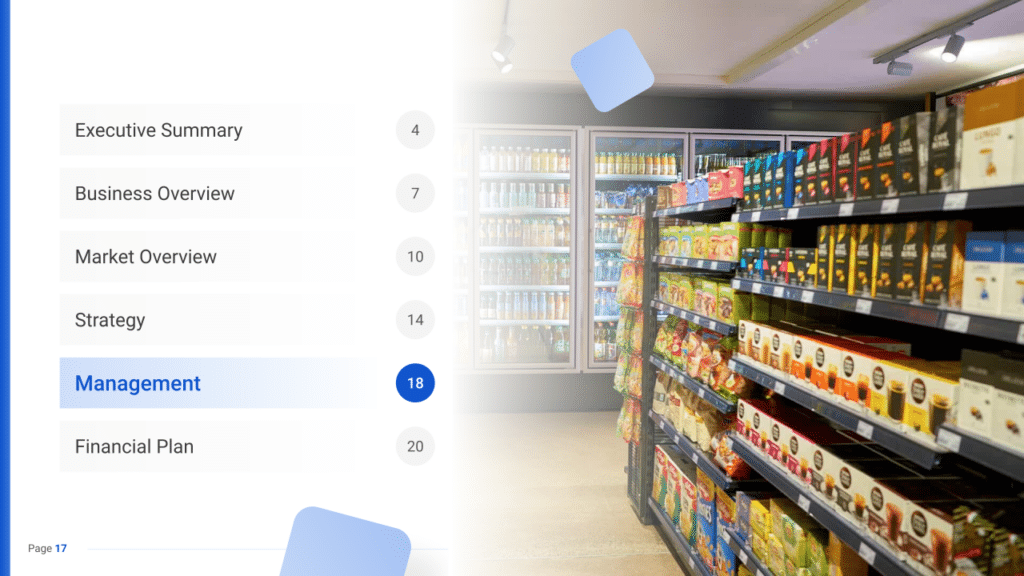

Financial Plan
The Financial Plan section is a comprehensive analysis of your financial projections for revenue, expenses, and profitability. It lays out your convenience store’s approach to securing funding, managing cash flow, and achieving breakeven.
This section typically includes detailed forecasts for the first 5 years of operation, highlighting expected revenue, operating costs and capital expenditures.
For your convenience store business plan, provide a snapshot of your financial statement (profit and loss, balance sheet, cash flow statement), as well as your key assumptions (e.g. number of customers and prices, expenses, etc.).
Make sure to cover here
_ Profit and Loss
_ Cash Flow Statement
_ Balance Sheet
_ Use of Funds









